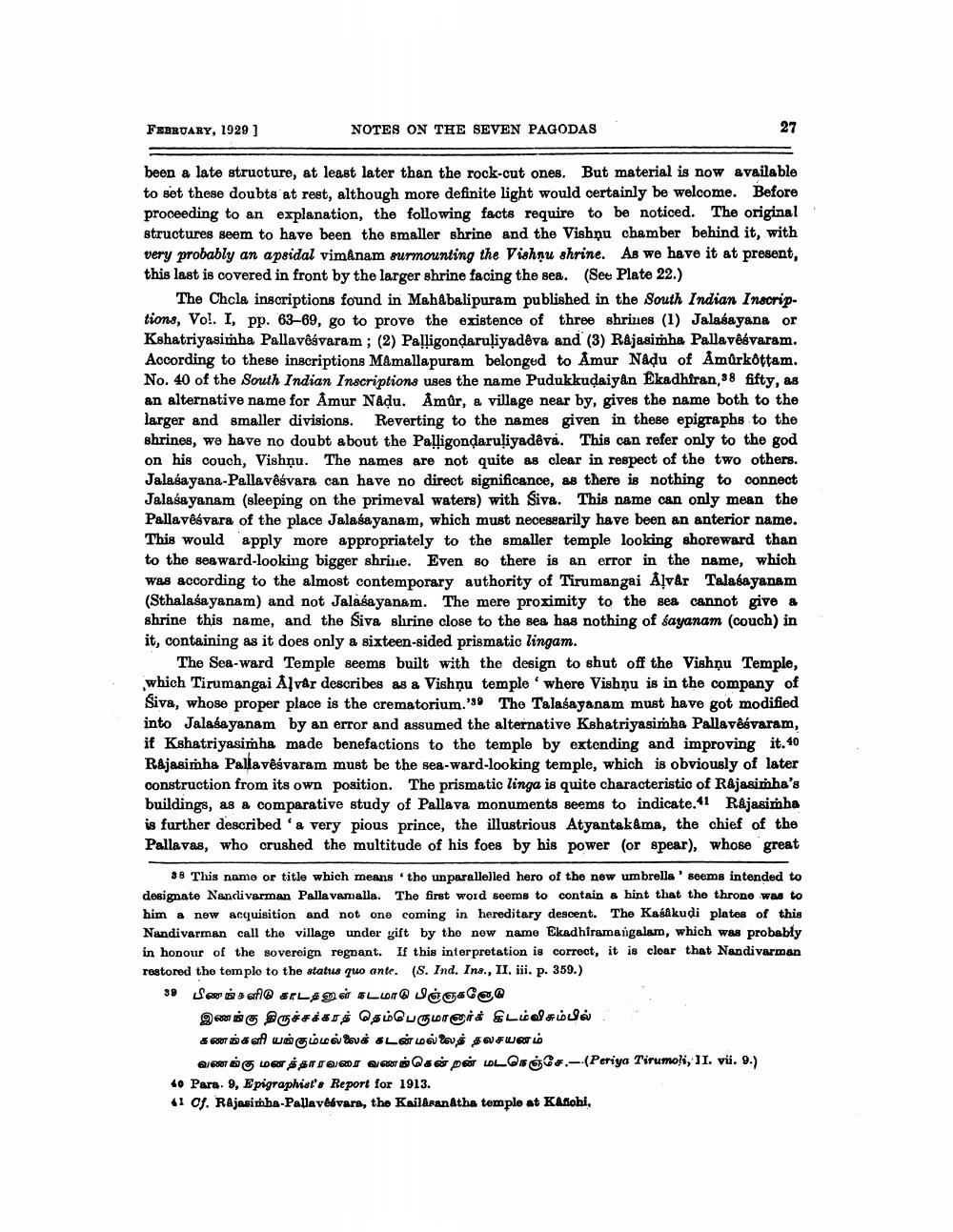________________
FEBRUARY, 1929 ]
NOTES ON THE SEVEN PAGODAS
27
been a late structure, at least later than the rock-cut ones. But material is now available to set these doubts at rest, although more definite light would certainly be welcome. Before proceeding to an explanation, the following facts require to be noticed. The original structures seem to have been the smaller shrine and the Vishnu chamber behind it, with very probably an apsidal vimanam surmounting the Vishnu shrine. As we have it at present, this last is covered in front by the larger shrine facing the sea. (See Plate 22.)
The Chcla inscriptions found in Mahabalipuram published in the South Indian Inscriptions, Vol. I, pp. 63–69, go to prove the existence of three shrines (1) Jalasayana or Kshatriyasimha Pallavêśvaram ; (2) Palligondaruliyadeva and (3) Rajasimha Pallavê varam. According to these inscriptions Mamallapuram belonged to Amur Nadu of Amůrkottam. No. 40 of the South Indian Inscriptions uses the name Pudukkudaiyan Ekadhfran, 38 fifty, as an alternative name for Amur Nadu. Amür, a village near by, gives the name both to the larger and smaller divisions. Reverting to the names given in these epigraphs to the shrines, we have no doubt about the Palligondaruliyadêva. This can refer only to the god on his couch, Vishnu. The names are not quite as clear in respect of the two others. Jalasayana-Pallavêśvara can have no direct significance, as there is nothing to connect Jalasayanam (sleeping on the primeval waters) with Siva. This name can only mean the Pallavêsvara of the place Jalasayanam, which must necesearily have been an anterior name. This would apply more appropriately to the smaller temple looking shoreward than to the seaward-looking bigger shrine. Even so there is an error in the name, which was according to the almost contemporary authority of Tirumangai Alvar Talabayanam (Sthalasa yanam) and not Jalasayanam. The mere proximity to the sea cannot give a shrine this name, and the Siva shrine close to the sea has nothing of sayanam (couch) in it, containing as it does only a sixteen-sided prismatic lingam.
The Sea-ward Temple seems built with the design to shut off the Vishnu Temple, which Tirumangai Alvar describes as a Vishnu temple where Vishnu is in the company of Siva, whose proper place is the crematorium.'89 The Talasayanam must have got modified into Jalasa yanam by an error and assumed the alternative Kshatriyasimha Pallavêávaram, if Kshatriyasimha made benefactions to the temple by extending and improving it.40 RAjasimha Pallavêśvaram must be the sea-ward-looking temple, which is obviously of later construction from its own position. The prismatic linga is quite characteristic of Rajasimha's buildings, as a comparative study of Pallava monuments seems to indicate.41 Rajasimha is further described ' a very pious prince, the illustrious Atyantakama, the chief of the Pallavas, who crushed the multitude of his foes by his power (or spear), whose great
88 This name or title which means the unparallelled hero of the new umbrella seems intended to designate Nandivarman Pallavamalla. The first word seems to contain a hint that the throne was to him a new acquisition and not one coming in hereditary descent. The Kasākudi plates of this Nandivarman call the village under gift by the new name Ekadhframangalam, which was probably in honour of the sovereign regnant. If this interpretation is correct, it is cloar that Nandivarman restored the templo to the status quo ante. (S. Ind. Ins., II. iii. p. 359.) 39 பிணங்களில் காடதனுள் நடமாடு பிஞ்ஞகனோடு
இணங்கு திருச்சக்கரத் தெம்பெருமானார்க் கிடம்விசும்பில் , கணங்களி யங்கும்மல்லைக் கடன் மல்லைத் தலசயனம்
BIGOT NG LRTS SN1/60s @ s par L & #.- (Periya Tirumoli, II. vi. 9.) 40 Para, 3, Epigraphist's Report for 1913. 41 Of. Rajasimba-Pallavesvara, the Kailasanatha temple at Kafiohi,




